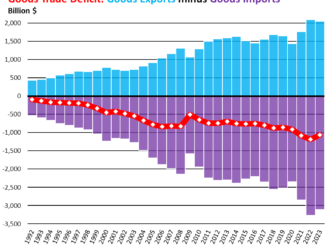
June 1, 2023
Data source: S&P Global Commodity Insights, China National Bureau of Statistics, China Energy Statistical Yearbooks
Note: Industrial consumption includes natural gas feedstock. Other includes district heating and transport.
In 2022, annual natural gas consumption in China declined by 1%, or 0.4 billion cubic feet per day (Bcf/d), from 2021, according to data from S&P Global Commodity Insights–the first decline in annual consumption since 1990, according to our International Energy Statistics. Slower economic growth, mainly resulting from widespread lockdowns associated with China’s zero-COVID policies, prompted the drop in natural gas consumption. Government policies also reprioritized energy supply security, including growth in coal production, over emissions targets.
China’s natural gas consumption more than tripled from 10.4 Bcf/d in 2010 to 35.1 Bcf/d in 2022. The industrial sector led China’s natural gas consumption growth during this period, increasing by 10.3 Bcf/d, followed by the residential and commercial sector at 6.5 Bcf/d and the electric power sector at 3.4 Bcf/d. Strong economic growth, urbanization, and environmental policies supporting coal-to-natural gas switching in an effort to reduce air pollution and meet emissions targets all contributed to rapid growth in China’s natural gas consumption over the last decade.
Data source: S&P Global Commodity Insights, China National Bureau of Statistics, China National Development and Reform Commission
Note: China’s domestic production grew at a compound annual growth rate of 7% between 2010 and 2022.
Rapid growth in domestic natural gas production, which more than doubled from 8.9 Bcf/d to 20.5 Bcf/d between 2010 and 2022, met about half of the increase in demand. Domestic production has expanded in China by more than 1.0 Bcf/d every year since 2017, mainly because of growth in conventional natural gas production. Production has also increased from low-permeability formations including tight gas, shale gas, and coalbed methane. In 2019, the Chinese government introduced a subsidy program that established incentives for production of natural gas from tight gas formations and extended existing subsidies for production from shale and coalbed methane resources. Between 2019 and 2022, tight gas production increased by 0.6 Bcf/d, and shale gas production increased by 0.8 Bcf/d.
Despite significant growth in domestic natural gas production, China has become increasingly dependent on imports because growth in demand has outpaced growth in domestic production. Natural gas imports (combined pipeline and liquefied natural gas [LNG]) accounted for 46% of China’s total natural gas supply in 2021 and 42% in 2022, an increase from 15% in 2010.
Data source: China General Administration of Customs, Global Trade Tracker
After becoming the world’s largest LNG importer in 2021, China’s LNG imports fell by 20% (2.0 Bcf/d) in 2022, mainly because of reduced demand and relatively high LNG spot prices. China’s LNG imports averaged 8.3 Bcf/d in 2022–the least since 2019, according to data from China’s General Administration of Customs. In 2022, imports by pipeline offset some of the declines in LNG imports, increasing by 8% (0.4 Bcf/d) compared with 2021, mainly because of increased flows from Russia via the Power of Siberia pipeline.
Principal contributors: Victoria Zaretskaya, Faouzi Aloulou
In 2022, annual natural gas consumption in China declined by 1%, or 0.4 billion cubic feet per day (Bcf/d), from 2021, according to data from S&P Global Commodity Insights–the first decline in annual consumption since 1990, according to our International Energy Statistics. Slower economic growth, mainly resulting from widespread lockdowns associated with China’s zero-COVID policies, prompted the drop in natural gas consumption. Government policies also reprioritized energy supply security, including growth in coal production, over emissions targets.



